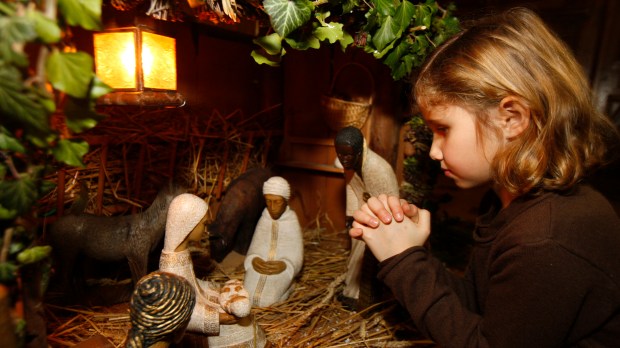How do we recover the mystery of Christmas? And how can we cultivate the grace of the Nativity throughout the year? Brother Eric Bidot, Capuchin, guardian of the convent of Clermont-Ferrand (in Puy-de-Dôme, France) spoke about it.
Why, in 1223, did St. Francis create a living Nativity scene?
Francis lived with Christ. He saw Him in the events and encounters of everyday life, recognized Him in his brothers, especially in the poorest. Francis had only one desire: to meet, to see, to touch his Lord. In the Gospel, there were two mysteries of Christ’s life that brought tears to his eyes: the Crucifixion and the Nativity. Francis presents himself as a “simple” man: he is an artist, poet, a sensitive soul. To understand the Gospel, he needed to see it, to touch it, to experience it.
How did people react?
They must have talked about it a lot in their thatch-roofed cottages! Although we have no trace of what Francis said in his proclamation, popular legend has it that the people were so touched that they took strands of straw home with them, to the point where there was not a single strand left. His way of talking about Jesus awakened faith and fervor.
I tend to think that Francis preached about the humility of God: how could the thrice-holy God, creator of the universe, master of time and history, become man and be born as an outcast? The Nativity scene revolutionizes the image we have of God: a God who humbles himself for our salvation.
How do we enter into the contemplation of this mystery?
We should let ourselves be unsettled and overtaken by the mystery that is before our eyes. We should accept the school of God’s humility. In order to applaud the greatest miracle in history, we must recover our childlike soul. We should be overwhelmed by the manger. And for that, our Nativity scenes will never be beautiful enough. Let’s try to make them true icons. Let us contemplate them and be deeply amazed by such a great mystery.
It is important that in the Nativity scene, the ordinary and concrete activities of people of yesterday and today, immersed in daily life, are represented. Why not add to the traditional figurines doctors, construction workers, farmers, shopkeepers, etc.? At the manger, the whole of Creation is summoned: the cosmos, the natural elements, the small and large of this world. God becomes man to renew and reconcile all Creation from within.
Is this the heart of the Nativity scene’s message?
The Nativity scene is a mystery of simplicity. Let us truly realize that the shepherds — the first witnesses to the birth of the Savior — were among the poorest and most disparaged of the Jews of their time. If we had the hearts and hands of the poor, we would easily enter into the jubilation of contemplating this great mystery.
At Christmas, the presence of Emmanuel (“God with us”) reveals to us the simplicity of Love. God is simple. It is we who are complicated by our sin. At the manger, God is there—a mystery that echoes St. Augustine’s exclamation: “You were within me, and I was outside, and it was there that I searched for You. You were with me but I was not with You; those created things kept me from You, yet if they had not been in You they would have not been at all!”
How can we cultivate the grace of Christmas throughout the year?
By letting God transform all our relationships: our relationship to Him, to ourselves and to others. This is not a psychological technique, it is a true spiritual conversion. And for this there is only one way: personal prayer. Without it, it is impossible to live by the grace of Christmas. It’s a bit blunt, but it’s the truth. Every day, God asks only to be reborn in us, to give us the peace and joy of Christmas. This is not a façade of peace and excited joy, but a deep peace and the joy of knowing that we are loved. Don’t we have at least five minutes each day for God to be born again in us?
At the risk of sounding naive, one question: why did God become incarnate?
To tell us that every person is a son or daughter of God! To reveal to us the true face of God and thus restore our relationship with the Father in heaven. “God became man so that man might become God,” said St. Irenaeus in the 2nd century. Jesus, by being truly God and truly man, reconciles in his person man with God and leads us to our true and full dimension. By becoming incarnate, the Eternal Word reveals the omnipotence of His goodness, mercy and tenderness. In Jesus, He makes Himself very close, very small so as not to frighten us. The manger, like the Eucharist, is the revelation of a God who makes himself the servant of every man to show us all his power of love. As one of the oldest Christmas carols says: “From the manger to the crucifixion, God gives us a very great mystery.”
Interview by Emmanuel Pellat

Read more:
A prayer of Pope St. John XXIII to recite before the crèche on Christmas

